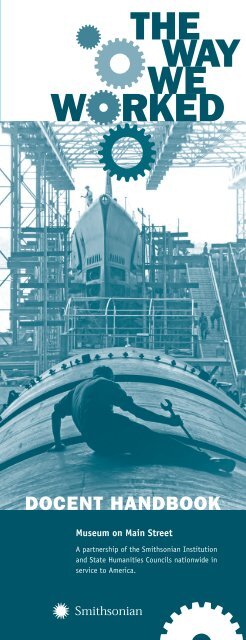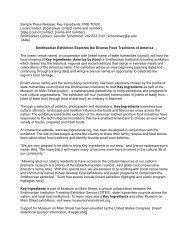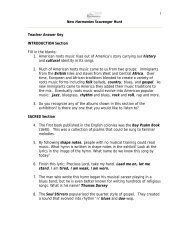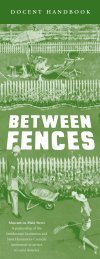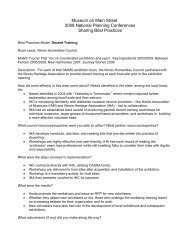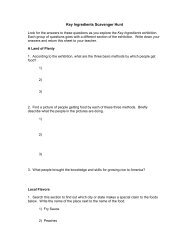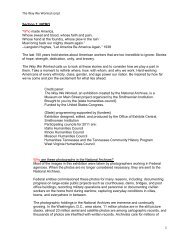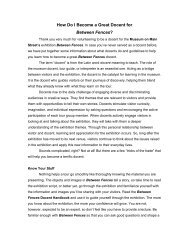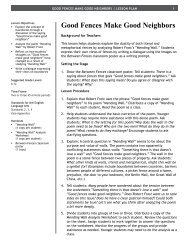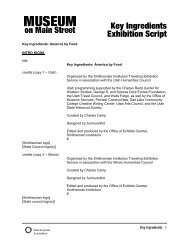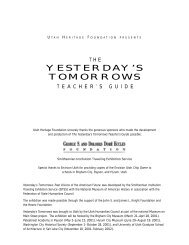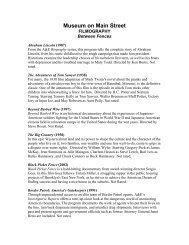Exhibition Docent Handbook - Museum on Main Street
Exhibition Docent Handbook - Museum on Main Street
Exhibition Docent Handbook - Museum on Main Street
Create successful ePaper yourself
Turn your PDF publications into a flip-book with our unique Google optimized e-Paper software.
THE<br />
WAY<br />
WE<br />
W RKED<br />
DOCENT HANDBOOK<br />
<str<strong>on</strong>g>Museum</str<strong>on</strong>g> <strong>on</strong> <strong>Main</strong> <strong>Street</strong><br />
A partnership of the Smiths<strong>on</strong>ian Instituti<strong>on</strong><br />
and State Humanities Councils nati<strong>on</strong>wide in<br />
service to America.
MUSEUM ON MAIN STREET (MoMS) is a partnership<br />
between the Smiths<strong>on</strong>ian Instituti<strong>on</strong> and state humanities<br />
councils nati<strong>on</strong>wide that serves small-town museums and<br />
their patr<strong>on</strong>s. This innovative project provides <strong>on</strong>e-of-akind<br />
access to Smiths<strong>on</strong>ian exhibiti<strong>on</strong>s and educati<strong>on</strong>al<br />
humanities programs. Most importantly, MoMS provides<br />
community museums and libraries an opportunity to<br />
showcase their strengths and reinforce their meaningful<br />
c<strong>on</strong>tributi<strong>on</strong>s to small-town life. Like all MoMS<br />
exhibiti<strong>on</strong>s, THE WAY WE WORKED was specifically<br />
designed to meet the needs of small organizati<strong>on</strong>s.<br />
Visit the exhibiti<strong>on</strong> website at<br />
www.<str<strong>on</strong>g>Museum</str<strong>on</strong>g><strong>on</strong><strong>Main</strong><strong>Street</strong>.org/TheWayWeWorked.<br />
For informati<strong>on</strong> about other <str<strong>on</strong>g>Museum</str<strong>on</strong>g> <strong>on</strong> <strong>Main</strong> <strong>Street</strong><br />
exhibiti<strong>on</strong>s, visit www.<str<strong>on</strong>g>Museum</str<strong>on</strong>g><strong>on</strong><strong>Main</strong><strong>Street</strong>.org.<br />
THE WAY WE WORKED is a <str<strong>on</strong>g>Museum</str<strong>on</strong>g> <strong>on</strong> <strong>Main</strong> <strong>Street</strong><br />
project developed by the Smiths<strong>on</strong>ian Instituti<strong>on</strong> Traveling<br />
<str<strong>on</strong>g>Exhibiti<strong>on</strong></str<strong>on</strong>g> Service, adapted from an original exhibiti<strong>on</strong><br />
from the Nati<strong>on</strong>al Archives.<br />
COVER: Submarine builder, CT, by Fenno Jacobs, 1943.<br />
Nati<strong>on</strong>al Archives, General Records of the U.S. Navy
Welcome !<br />
This docent handbook will assist you in helping visitors<br />
appreciate and enjoy The Way We Worked. The handbook<br />
leads you through the exhibiti<strong>on</strong>—secti<strong>on</strong>-by-secti<strong>on</strong>—<br />
and offers ideas, themes, and questi<strong>on</strong>s designed to inspire<br />
meaningful discussi<strong>on</strong> during your tours. Your job is to<br />
encourage visitors to think about the subject matter and<br />
invite them to share memories and pers<strong>on</strong>al c<strong>on</strong>necti<strong>on</strong>s<br />
to the exhibit.<br />
The Way We Worked c<strong>on</strong>sists of an introducti<strong>on</strong> and<br />
four c<strong>on</strong>tent secti<strong>on</strong>s. This handbook follows the same format.<br />
An overview text providing a synopsis of major c<strong>on</strong>cepts<br />
for each secti<strong>on</strong>’s themes is followed by “Think About It,”<br />
“Let’s Talk,” and, in some cases, “For Students and Families,”<br />
“Let’s Listen” or “Let’s Watch” questi<strong>on</strong>s.<br />
“Think About It” highlights important points in each secti<strong>on</strong><br />
to encourage visitors to reflect. “Let’s Talk” offers questi<strong>on</strong>s<br />
to ask visitors. Most are open-ended; the answers to others<br />
can be found in the exhibiti<strong>on</strong> text. “For Students and<br />
Families” questi<strong>on</strong>s are geared toward younger visitors.<br />
“Let’s Listen” and “Let’s Watch” remind you to encourage<br />
visitors to listen to audio or view a video found in the<br />
exhibiti<strong>on</strong>.<br />
Review this handbook and the exhibiti<strong>on</strong> script, available<br />
<strong>on</strong>line at www.<str<strong>on</strong>g>Museum</str<strong>on</strong>g><strong>on</strong><strong>Main</strong><strong>Street</strong>.org, to become familiar<br />
with the exhibiti<strong>on</strong>. Remember, a docent is not expected<br />
to be an expert. You’re here to initiate and lead a discussi<strong>on</strong>.<br />
Visitors in an organized group usually feel more comfortable<br />
speaking up; those who arrive individually and join a tour<br />
may require some coaxing. You d<strong>on</strong>’t have to ask all the<br />
questi<strong>on</strong>s in this handbook. Just <strong>on</strong>e questi<strong>on</strong> can spark<br />
an animated discussi<strong>on</strong>. You’ll learn quickly which questi<strong>on</strong>s<br />
work best for different age groups and how l<strong>on</strong>g you need<br />
to spend in each secti<strong>on</strong>. Share what you learn <strong>on</strong> your tours<br />
with fellow docents. Your experience may help them with<br />
their tour.<br />
Helpful hints <strong>on</strong> being an effective and engaging docent are<br />
at the end of this handbook. While this handbook was specifically<br />
designed for The Way We Worked, we hope that<br />
you’ll extend your skills to initiate discussi<strong>on</strong>s about related<br />
displays, artifacts, and stories from your own community.<br />
— The <str<strong>on</strong>g>Museum</str<strong>on</strong>g> <strong>on</strong> <strong>Main</strong> <strong>Street</strong> Team<br />
<str<strong>on</strong>g>Docent</str<strong>on</strong>g> <str<strong>on</strong>g>Handbook</str<strong>on</strong>g> 1
THE<br />
WAY<br />
WE<br />
W RKED<br />
SUMMARY<br />
Workers are the backb<strong>on</strong>e of American society. Known<br />
for their str<strong>on</strong>g work ethic, Americans invest themselves<br />
physically, emoti<strong>on</strong>ally, and intellectually in<br />
their work.<br />
American jobs are as diverse as the American workforce.<br />
The opportunity provided by work is central to<br />
the American dream and has attracted people to better<br />
lives in America. With strength, ingenuity, creativity,<br />
thoughtfulness, and heroics, American workers keep<br />
our ec<strong>on</strong>omy and our society up and running. Our jobs<br />
and lives are interc<strong>on</strong>nected, helping to keep America<br />
going str<strong>on</strong>g.<br />
2 The Way We Worked
7 Mechanic works <strong>on</strong> a turbine, New York City, by Lewis W. Hine, 1924.<br />
Nati<strong>on</strong>al Archives, Records of the Works Progress Administrati<strong>on</strong><br />
Think About It<br />
Ask visitors what work they do. Encourage visitors to c<strong>on</strong>sider<br />
how even <strong>on</strong>e pers<strong>on</strong>’s work helps sustain a community.<br />
Then, c<strong>on</strong>sider how our work is c<strong>on</strong>nected or intertwined<br />
both locally and nati<strong>on</strong>ally.<br />
Let’s Talk<br />
Explore the introducti<strong>on</strong> to the exhibiti<strong>on</strong>. Ask visitors to<br />
talk about the significance of the large gear motif and the<br />
column of images of American workers Some might notice<br />
that the gears symbolize how our jobs and lives are interc<strong>on</strong>nected<br />
or that workers are symbolized by a pillar of strength.<br />
Ask visitors to read the passage from Langst<strong>on</strong> Hughes’ 1935<br />
poem “Let America Be America Again.” Discuss how Hughes,<br />
an African American poet, explores whether the America of<br />
his time has fulfilled its dreams of equality and promise.<br />
How does work relate to that dream<br />
Ask visitors to list reas<strong>on</strong>s why government photographers<br />
would take photos of workers and workplaces. What might<br />
have been happening in America when the photograph was<br />
taken<br />
Let’s Watch<br />
å Watch the video featuring historic footage of workers<br />
and listen to the lyrics of the s<strong>on</strong>g “We Do the Work.” What<br />
does the wide variety of work d<strong>on</strong>e by Americans tell you<br />
about our country Did you see something that surprised<br />
you How has work changed<br />
5 Rolling logs into a river, MI, by W.J. Beal, 1901. Nati<strong>on</strong>al Archives,<br />
Records of the Forest Service<br />
<str<strong>on</strong>g>Docent</str<strong>on</strong>g> <str<strong>on</strong>g>Handbook</str<strong>on</strong>g> 3
Where We Work<br />
1 Weeding sugar beets for $2.00 an hour, near Fort Collins, CO, by<br />
Bill Gillette, 1972. Nati<strong>on</strong>al Archives, Records of the Envir<strong>on</strong>mental<br />
Protecti<strong>on</strong> Agency<br />
SUMMARY<br />
Imagine the darkness of a coal mine, the fierce winds<br />
atop a skyscraper, the heat of a foundry against your<br />
skin, or the noises and bustle of a hospital. Americans<br />
work nearly everywhere. Every workplace brings<br />
different experiences and challenges. Where we work<br />
affects when we work, with whom we work, and the<br />
way we work.<br />
4 The Way We Worked
Think About It<br />
Ask visitors to read the banner and think about all of the<br />
different places they have worked. Encourage them to c<strong>on</strong>sider<br />
how that workplace envir<strong>on</strong>ment affected their work.<br />
Let’s Talk<br />
Documentary and reality televisi<strong>on</strong> shows often look at<br />
unique jobs or dangerous workplaces. Have you watched<br />
series like “Deadliest Catch,” “Ice Road Truckers,” or “Cake<br />
Boss” Why do you think shows like these are popular<br />
What would a show about your job be called<br />
<str<strong>on</strong>g>Docent</str<strong>on</strong>g> <str<strong>on</strong>g>Handbook</str<strong>on</strong>g> 5
Where We Work:<br />
In the Elements<br />
Summary<br />
Milli<strong>on</strong>s of Americans spend part or all of their working<br />
lives outdoors. Comfort is relative, and weather calls the<br />
shots. They know what it feels like to haul in a fish net<br />
<strong>on</strong> swelling seas or dig hundreds of feet into the earth.<br />
Some of these jobs come and go with the seas<strong>on</strong>s. But<br />
workers adapt their lives to shifting c<strong>on</strong>diti<strong>on</strong>s.<br />
Americans in the military must be prepared to work in<br />
any envir<strong>on</strong>ment and deal with danger and adversity<br />
every day. Global threats may take them to any corner<br />
of the world at a moment’s notice. Local crises might<br />
summ<strong>on</strong> them to help their home communities.<br />
1 Workman <strong>on</strong> the framework of the Empire State Building, New York<br />
City, ca. 1930–31. Nati<strong>on</strong>al Archives, Records of the Works Progress<br />
Administrati<strong>on</strong><br />
6 The Way We Worked
1 Aircraft carrier USS Theodore Roosevelt, by Mass Communicati<strong>on</strong><br />
Specialist 3rd Class J<strong>on</strong>athan Snyder, 2008. U.S. Department of<br />
Defense, U.S. Navy<br />
Think About It<br />
Look at all of the photographs of people working <strong>on</strong> the<br />
seas, in mines, and outdoors. What does it take—professi<strong>on</strong>ally,<br />
physically, and mentally—to work in those places<br />
Let’s Talk<br />
Ask visitors to look at the photograph of the skyscraper<br />
c<strong>on</strong>structi<strong>on</strong> worker. What are some of the dangers and challenges<br />
these workers face What are some of the challenges<br />
faced by workers in other envir<strong>on</strong>ments like mines or working<br />
<strong>on</strong> the sea Despite potential dangers, many Americans feel<br />
stifled working in an office or factory job. What are the<br />
advantages to working in the elements<br />
During the three weeks I spent there, I never saw the<br />
sunlight because we went down in the mine before the<br />
sun came out and we finished work after the sun had set.<br />
–John Lukasavicius, 1939<br />
Ask visitors to read the quote from John Lukasavicius. What<br />
led Lukasavicius to leave his work in a coal mine Then, look<br />
together at the photo of the men in fr<strong>on</strong>t of a mining car. Why<br />
do you think others decided to c<strong>on</strong>tinue working in the mines<br />
Ask visitors to spin the photographs to see similar jobs being<br />
performed in both military and civilian envir<strong>on</strong>ments. In<br />
what ways does serving in the military mirror civilian work<br />
In what ways does military service differ<br />
Invite visitors to look at the farm image. What would happen <strong>on</strong><br />
the farm if there were heavy rain or blazing heat What other<br />
jobs might be affected by weather and seas<strong>on</strong>al changes<br />
<str<strong>on</strong>g>Docent</str<strong>on</strong>g> <str<strong>on</strong>g>Handbook</str<strong>on</strong>g> 7
Where We Work:<br />
In Our Communities<br />
and Old Jobs, New Jobs<br />
1 Internati<strong>on</strong>al Associati<strong>on</strong> of Fire Fighters photograph, ca. 1960.<br />
Nati<strong>on</strong>al Archives, General Records of the Department of Labor<br />
Summary<br />
Can you imagine community life without teachers,<br />
postal carriers, barbers, firefighters, police officers, or<br />
trash collectors We see them every day, come to know<br />
them by name, or even regard them as family. These<br />
workers may have drastically different jobs and work<br />
envir<strong>on</strong>ments, but they all provide vital services to our<br />
communities.<br />
In the 20th century, dramatic changes have occurred in<br />
America’s workplaces. Some jobs were invented while<br />
others ceased to exist. In 1900, a visit from the milkman<br />
at your door was routine. Today, a delivery is more<br />
likely to be a pizza.<br />
8 The Way We Worked
Think About It<br />
Ask visitors to think about their communities as workplaces,<br />
and look at the images of the music teacher, pastor, doctors,<br />
sanitati<strong>on</strong> worker, postal worker and rescue workers. What are<br />
some other jobs that serve communities Describe what life<br />
would be like in your community without their c<strong>on</strong>tributi<strong>on</strong>s.<br />
Let’s Talk<br />
Nearly 400 firefighters and police officers died resp<strong>on</strong>ding to<br />
the 9/11 attacks. Who are the unsung heroes in your community<br />
Ask visitors to share stories about other rescue workers<br />
who have saved lives in their communities. Are there any<br />
local stories of community workers who sacrificed their own<br />
lives <strong>on</strong> the job to assist the public<br />
Look at the photo of the sanitati<strong>on</strong> worker collecting garbage.<br />
What elements of his job make it dangerous What other<br />
municipal or county jobs could be c<strong>on</strong>sidered dangerous<br />
Teaching might even be the greatest of the arts since the<br />
medium is the human mind and spirit. –John Steinbeck<br />
Review with visitors the John Steinbeck quote. What do you<br />
think Steinbeck means by comparing the work of teachers<br />
to that of artists What impact do teachers have <strong>on</strong> their<br />
communities<br />
Ask visitors to look at the 1918 image of the women<br />
delivering ice. Why was their job necessary early in the 20th<br />
century What jobs in your community have disappeared as<br />
technology changed What new <strong>on</strong>es have appeared<br />
1 Women delivering ice, 1918. Nati<strong>on</strong>al Archives, Records of the War<br />
Department General and Special Staffs<br />
<str<strong>on</strong>g>Docent</str<strong>on</strong>g> <str<strong>on</strong>g>Handbook</str<strong>on</strong>g> 9
Where We Work:<br />
Within Four Walls<br />
Summary<br />
More Americans work within the walls of an office,<br />
factory, or store today than in 1900. Even the home is<br />
a workplace, where the unpaid labor of mothers, fathers,<br />
and children is indispensable. Just like work outdoors,<br />
the demands placed <strong>on</strong> workers in these settings are as<br />
varied as the places themselves. And, sometimes the<br />
work can be just as dangerous.<br />
Think About It<br />
Encourage visitors to think about how workplaces changed<br />
in the 20th century. Where do most people in your area work<br />
today Are those workplaces indoors or outdoors<br />
Let’s Talk<br />
Compare the 1950s’ images of the office, where the workers<br />
share the same desks, with the private cubicles of the 2000s.<br />
How do pers<strong>on</strong>al office spaces improve working envir<strong>on</strong>ments<br />
and productivity What are the positive and negative aspects<br />
Ask visitors to look at all of the photos of people doing work<br />
in their homes. Some are doing housework; others are making<br />
a living from the work they do in their homes. What are<br />
the different jobs that exist in your home Are they paid<br />
or unpaid What roles do members of your household play<br />
How did indoor work in factories change work cycles in the<br />
United States Did the move from agricultural work to working<br />
by the clock ever affect your community and your family<br />
1 The Battaglia family sewing trousers, New York City, by Lewis W.<br />
Hine, 1908. Nati<strong>on</strong>al Archives, Records of the Children’s Bureau<br />
10 The Way We Worked
1 Tapping a blast furnace at the M. A. Hana Steel Co., NY, by<br />
Thomas W. Parker, ca. 1950. Nati<strong>on</strong>al Archives, Records of the<br />
U.S. Informati<strong>on</strong> Agency<br />
For Students and Families<br />
Ask students to look at the 1908 photo of the family sewing<br />
trousers and to be aware of other photographs that show<br />
children working. How does their work differ from the work<br />
that your parents ask you to do<br />
Review the graphic showing the percentage of the workforce<br />
involved in managerial, clerical, and sales work. Ask students<br />
to explain why they would prefer to work in an office, a factory,<br />
a home, or outdoors.<br />
1 Lever Brothers office building, New York City, Lever House<br />
photograph, ca. 1959. Nati<strong>on</strong>al Archives, Records of the U.S.<br />
Informati<strong>on</strong> Agency<br />
<str<strong>on</strong>g>Docent</str<strong>on</strong>g> <str<strong>on</strong>g>Handbook</str<strong>on</strong>g> 11
How We Worked<br />
Summary<br />
For most of human history, people did their jobs by hand<br />
or with the help of basic tools. Beginning in the late<br />
18th century, the Industrial Revoluti<strong>on</strong> introduced huge<br />
labor-saving technologies and increased our productivity.<br />
Farm tools and machines made the round-the-clock work<br />
of farming less labor intensive. We produced more goods,<br />
more cheaply, and in less time than ever before.<br />
This revoluti<strong>on</strong> also moved many people away from the<br />
countryside and into urban factories and mills. Efficiency<br />
sometimes meant little regulati<strong>on</strong> with l<strong>on</strong>g work hours,<br />
low pay, and scant attenti<strong>on</strong> to safety. Workers saw<br />
collective acti<strong>on</strong> as their best protecti<strong>on</strong> and fought for<br />
change. Technology c<strong>on</strong>tinues to change the landscape<br />
of our nati<strong>on</strong> and our workers al<strong>on</strong>g with it.<br />
12 The Way We Worked
1 Switchboard operators direct overseas calls, 1943. Nati<strong>on</strong>al<br />
Archives, Records of the Women’s Bureau<br />
Every great inventi<strong>on</strong> takes a livelihood away from<br />
50,000 men & within ten years creates a livelihood for<br />
half a milli<strong>on</strong>. –Mark Twain, 1888<br />
Think About It<br />
Dr. Bruce Bustard of the Nati<strong>on</strong>al Archives, curator of<br />
The Way We Worked, believes that most Americans hold<br />
a positive view of technology and mechanizati<strong>on</strong>. Read the<br />
quote from Mark Twain’s letter to William Dean Howells and<br />
ask visitors to discuss the positive and negative attributes<br />
of new technologies. In what ways do you agree or disagree<br />
with Twain<br />
<str<strong>on</strong>g>Docent</str<strong>on</strong>g> <str<strong>on</strong>g>Handbook</str<strong>on</strong>g> 13
How We Worked:<br />
From Agriculture<br />
to Industry<br />
1 Harrowing the fields, IA, by Irving Rusinow, 1941. Nati<strong>on</strong>al Archives,<br />
Records of the Bureau of Agricultural Ec<strong>on</strong>omics<br />
Summary<br />
In 1900, the majority of Americans lived <strong>on</strong> farms,<br />
and about 38 percent of workers declared farming as<br />
their main occupati<strong>on</strong>. By 2000, roughly 2 percent of<br />
Americans worked <strong>on</strong> farms. Mechanizati<strong>on</strong> and the<br />
growth of more urban industries partly explain this shift.<br />
New farm equipment, such as the thresher and motorized<br />
tractor, required fewer field workers. Former farmhands<br />
looked for work in cities, where technology led to a boom<br />
of factories, plants, and mills. Speedy new assembly lines<br />
and producti<strong>on</strong> tools changed the face of our factories<br />
and jobs.<br />
Think About It<br />
Ask visitors to share stories about people they know who<br />
moved from farms to other towns and cities to take industrial<br />
jobs. What has this shift meant to jobs and the job markets<br />
in their area<br />
Let’s Talk<br />
Ask visitors to look at the image of the Iowa farmer using<br />
a tractor and a horse-drawn plow. How did mechanizati<strong>on</strong><br />
affect farms<br />
14 The Way We Worked
Ask visitors to look at the “Help in the Home” page in the<br />
“We Run <strong>on</strong> Human Power” flipbook. What machine is the<br />
woman using to do her laundry (See if they recognize the<br />
mangle, which was used to wring water from cloth). Tools<br />
are invented to help ease the burden of cleaning and cooking.<br />
Which household devices are most helpful Which tools sit<br />
in a closet or garage unused<br />
Look at the large image of the worker posing with the “fiveyard<br />
dipper” used in the c<strong>on</strong>structi<strong>on</strong> of a dam. How would<br />
using such equipment make work faster and safer How could<br />
the tool be dangerous for a worker Can you think of major<br />
c<strong>on</strong>structi<strong>on</strong> projects d<strong>on</strong>e in your community that require<br />
these sorts of machines<br />
For Students and Families<br />
Ask students to scan the graphic showing how the number of<br />
farmers in the United States declined during the 20th century.<br />
Ask if they’ve ever visited a farm or if they know of a pers<strong>on</strong><br />
or family member who is a farmer. How can we c<strong>on</strong>tinue to<br />
provide food for the country when we have fewer farms<br />
Let’s Watch<br />
å Watch the footage of technology at work. How did<br />
mechanized industrial processes increase productivity In<br />
what ways might an assembly line or a new machine benefit<br />
an employer, but not a worker How would you react in a<br />
similar situati<strong>on</strong><br />
1 Workers assemble radios, NY, 1945. Nati<strong>on</strong>al Archives, Records of<br />
the Office of War Informati<strong>on</strong><br />
<str<strong>on</strong>g>Docent</str<strong>on</strong>g> <str<strong>on</strong>g>Handbook</str<strong>on</strong>g> 15
How We Worked:<br />
It’s a Small<br />
Working World<br />
Summary<br />
Every new microchip, satellite, or handheld device offers<br />
an opportunity for workers to communicate faster and<br />
increase efficiency. Communicati<strong>on</strong> tools became more<br />
and more critical for American workers during the 20th<br />
century. The teleph<strong>on</strong>e, mainframe and pers<strong>on</strong>al computers,<br />
and wireless technologies made it possible to<br />
work, access informati<strong>on</strong>, and engage with colleagues<br />
regardless of locati<strong>on</strong>. Technology links workers across<br />
great distances and is now an inescapable part of<br />
every<strong>on</strong>e’s work life.<br />
I remember the days when we used to lug around …<br />
those 55-pound early portable computers. No w<strong>on</strong>der<br />
my lower back kills me today! –Laura Campbell, ca. 1980<br />
Think About It<br />
Read the Laura Campbell quote. Ask visitors to look at all<br />
of the images and think about how quickly the tools we<br />
use have become smaller and more efficient. How have<br />
communicati<strong>on</strong>s technologies evolved during your career<br />
How has your work changed Do these tools make your<br />
work easier or more complicated<br />
5 Computer complex for handling travel reservati<strong>on</strong>s, 1968. ©IBM<br />
Corporate Archives<br />
16 The Way We Worked
1 New York City Police Department, ca. 1908. Library of C<strong>on</strong>gress,<br />
George Grantham Bain Collecti<strong>on</strong>, Prints and Photographs Divisi<strong>on</strong><br />
Let’s Talk<br />
What are the pros and c<strong>on</strong>s of wireless technologies How<br />
have wireless ph<strong>on</strong>es, e-mails, and text messages affected<br />
the boundaries between our work lives and our pers<strong>on</strong>al lives<br />
Communicati<strong>on</strong>s tools may be a worker’s <strong>on</strong>ly lifeline to<br />
fellow workers. Ask visitors to name some jobs where the<br />
ability to communicate with a home base is crucial.<br />
For Students and Families<br />
Ask students to look at the communicati<strong>on</strong>s objects and<br />
see if they can identify them. Ask which item delivers a<br />
message most quickly. Then, review the graphic describing the<br />
speed for sending messages via P<strong>on</strong>y Express, via telegraph,<br />
and e-mail and texting. How do students think we will<br />
communicate in the future<br />
5 A farmer and an agr<strong>on</strong>omist review crop data, by Bruce Fritz, ca.<br />
2005. U.S. Department of Agriculture<br />
<str<strong>on</strong>g>Docent</str<strong>on</strong>g> <str<strong>on</strong>g>Handbook</str<strong>on</strong>g> 17
How We Worked:<br />
Workers Unite<br />
1 Triangle Shirtwaist Factory protestors, NY, 1911. Nati<strong>on</strong>al Archives,<br />
General Records of the Department of Labor<br />
Summary<br />
As large groups of Americans began working in potentially<br />
dangerous envir<strong>on</strong>ments, the possibility of physical injury,<br />
exploitati<strong>on</strong>, discriminati<strong>on</strong>, and harm increased. Some<br />
workers began to uni<strong>on</strong>ize, banding together to negotiate<br />
for better wages, hours, working c<strong>on</strong>diti<strong>on</strong>s, and work rules.<br />
Children were always (and still are) part of the workforce,<br />
assisting their families with work at home or <strong>on</strong> the farm.<br />
By 1890, 19 percent of American children aged 10–15<br />
worked outside their homes. Minimum age standards for<br />
child workers were finally enforced at the nati<strong>on</strong>al level<br />
in 1938 with the passage of the Fair Labor Standards Act.<br />
Think About It<br />
Ask visitors to c<strong>on</strong>sider the importance of uni<strong>on</strong>izati<strong>on</strong> in<br />
American work history. What are the benefits or drawbacks of<br />
uni<strong>on</strong>s How has work in your community been affected by<br />
uni<strong>on</strong>s How are uni<strong>on</strong>s perceived in your community today<br />
18 The Way We Worked
Let’s Talk<br />
Photographer Lewis Hine, who took many of the photos<br />
showing children at work, was an activist with a camera,<br />
depicting situati<strong>on</strong>s that highlighted societal issues. Are<br />
there other photographs in the exhibit that were taken to<br />
motivate people or promote an agenda<br />
Ask visitors to compare three images: the workers protesting<br />
after the 1911 Triangle Shirtwaist Factory fire; the activists<br />
for equal protecti<strong>on</strong>s for disabled Americans; and the 1934<br />
clash between a worker and a police officer. In all three<br />
photos, workers are protesting for better working c<strong>on</strong>diti<strong>on</strong>s<br />
or better pay. Why are some work protests peaceful and<br />
others violent<br />
Compare the 1867 image of the Nevada miner and the<br />
1967 radiati<strong>on</strong> lab. Which worker is better protected What<br />
advancements in the 20th century made it safer to work<br />
How did the workers’ movements of the early 20th century<br />
affect workplaces<br />
Let’s Listen<br />
ƒ Listen to the s<strong>on</strong>gs <strong>on</strong> the audio unit. Why do you think<br />
music played such an important role in motivating and maintaining<br />
solidarity am<strong>on</strong>g striking workers<br />
5 Loom workers at Bibb Mill No. 1, GA, by Lewis W. Hine, 1909.<br />
Nati<strong>on</strong>al Archives, Records of the Children’s Bureau<br />
<str<strong>on</strong>g>Docent</str<strong>on</strong>g> <str<strong>on</strong>g>Handbook</str<strong>on</strong>g> 19
Who Works<br />
1 South Texas Panorama (post office, Alice, TX), by Warren Hunter,<br />
oil <strong>on</strong> canvas, 1939. Smiths<strong>on</strong>ian American Art <str<strong>on</strong>g>Museum</str<strong>on</strong>g>, accessi<strong>on</strong><br />
no.: 1968.115<br />
Summary<br />
Our diverse, interc<strong>on</strong>nected workforce is a key part of<br />
our nati<strong>on</strong>’s story. Every pers<strong>on</strong>’s talent and perspective<br />
adds a new facet. No specific age, gender, class, or<br />
ethnicity typifies American workers. This diversity<br />
remains str<strong>on</strong>g because American workers dream big<br />
and work hard. Americans search for new opportunities<br />
to build a better future. New immigrants seek to fulfill<br />
their dreams through work. Every<strong>on</strong>e can enrich the<br />
picture. Together, America works.<br />
20 The Way We Worked
Think About It<br />
Ask visitors to read the excerpt from Walt Whitman’s “I Hear<br />
America Singing” and think about the poem al<strong>on</strong>g with the<br />
mural South Texas Panorama. Why do we need the c<strong>on</strong>tributi<strong>on</strong>s<br />
of so many different workers, from different backgrounds,<br />
doing different things How does this diversity help America<br />
thrive<br />
Let’s Talk<br />
During the 1930s, the Federal government commissi<strong>on</strong>ed<br />
artwork. Dozens of artists painted hundreds of murals for<br />
post offices and other public buildings across the country.<br />
Many artists used these murals to paint a positive, often<br />
celebratory portrait, of American workers. Why was this<br />
positive view important to artists during the Great Depressi<strong>on</strong><br />
Is there a mural h<strong>on</strong>oring workers in your community<br />
<str<strong>on</strong>g>Docent</str<strong>on</strong>g> <str<strong>on</strong>g>Handbook</str<strong>on</strong>g> 21
Who Works:<br />
Dreams and<br />
Opportunities<br />
Summary<br />
1 Porters in Erie Railroad lounge car, ca. 1949. Nati<strong>on</strong>al Archives,<br />
Records of the U.S. Informati<strong>on</strong> Agency, Erie Railroad Company<br />
photograph<br />
Summary<br />
The “American Dream” is a powerful ideal. Our definiti<strong>on</strong><br />
of this dream may differ, but we can all be inspired by its<br />
optimism. Work is often the vehicle through which people<br />
strive to achieve their dreams. Most came with an abundance<br />
of hope that working in America was their chance<br />
for a better life. Americans who were here already made<br />
a similar leap, moving to find work when times got rough.<br />
African Americans in the south sought jobs in the north<br />
and west to escape segregati<strong>on</strong>. During the Great Depressi<strong>on</strong>,<br />
many Americans became migrant workers in farm<br />
fields. And people c<strong>on</strong>tinue to uproot their lives today,<br />
seeking out more rewarding work.<br />
Think About It<br />
Dreams of achieving financial success through work or land<br />
ownership were am<strong>on</strong>g the primary motivati<strong>on</strong>s for people<br />
coming to America during the 19th and 20th centuries.<br />
Look through the flipbook to explore stories from people<br />
who migrated to find opportunity. Ask visitors to share<br />
stories from their own families about ancestors who moved<br />
in search of work.<br />
22 The Way We Worked
Let’s Talk<br />
What types of work helped establish your community Do<br />
people c<strong>on</strong>tinue to move to your area to find work Do<br />
people leave your area today in search of new opportunities<br />
Ask visitors to share their own stories about moving for work.<br />
Read the quote from Dr. Martin Luther King, Jr. In what<br />
ways do you think American society has fulfilled the promise<br />
of equal access to work for people of all races and cultural<br />
backgrounds In what ways have we fallen short<br />
We refuse to believe that there are insufficient funds in<br />
the great vaults of opportunity of this nati<strong>on</strong>.<br />
–Dr. Martin Luther King, Jr., 1963<br />
For Students and Families<br />
Look at the photo of the man perusing ads in the window<br />
of the Italian-American Employment Agency. Then, review<br />
the graphic listing the percentage of workers born in foreign<br />
countries in three communities. If you moved to a new place<br />
and were looking for work, how would you know where to<br />
go and what work to do Who would you turn to for help<br />
Explain that many immigrants often seek advice from others<br />
from their home countries to find work and housing when<br />
they arrive in America.<br />
ƒLet’s Listen<br />
Use your ph<strong>on</strong>e to call the cell ph<strong>on</strong>e tour “stop”<br />
listed <strong>on</strong> this side of the exhibiti<strong>on</strong>. Play the clip <strong>on</strong> how<br />
immigrati<strong>on</strong> has affected the diversity of the workforce in your<br />
state. What are the jobs in your area that attract workers from<br />
other countries today How are those jobs different from the<br />
<strong>on</strong>es that beck<strong>on</strong>ed immigrants to your area 50, and even 100,<br />
years ago<br />
1 Chinese shrimp fishermen, CA, 1889. Gulf of <strong>Main</strong>e Cod Project,<br />
NOAA Nati<strong>on</strong>al Marine Sanctuaries; Nati<strong>on</strong>al Archives<br />
<str<strong>on</strong>g>Docent</str<strong>on</strong>g> <str<strong>on</strong>g>Handbook</str<strong>on</strong>g> 23
Who Works:<br />
At Any Age<br />
Summary<br />
Do you remember your first job Was it a paper route,<br />
at the register of a local grocery store, or <strong>on</strong> the family<br />
farm Or are you close to retirement age with no<br />
intenti<strong>on</strong> of slowing down<br />
We can go through several work “stages” in our lives.<br />
Some of us experience a hard day’s work at very young<br />
ages through a family business; others get their first<br />
taste of work as teenagers with summer jobs, as apprentices,<br />
or interns. We may hold several jobs to climb the<br />
professi<strong>on</strong>al ladder or switch careers entirely. Americans<br />
are working later in life today than just a generati<strong>on</strong> ago.<br />
The noti<strong>on</strong> that work is central to life and builds a str<strong>on</strong>g<br />
character feeds the American work ethic.<br />
1 Working overtime, Washingt<strong>on</strong>, D.C., by Joseph O’D<strong>on</strong>nell, 1949.<br />
Nati<strong>on</strong>al Archives, Records of the U.S. Informati<strong>on</strong> Agency<br />
24 The Way We Worked
1 Naval yard employee instructing an apprentice, ca. 1942. Nati<strong>on</strong>al<br />
Archives, Franklin Delano Roosevelt Library Public Domain Photographs<br />
Think About It<br />
Look at the photos of the secretary working late and the<br />
early morning food delivery. What do you think it means to<br />
“burn the midnight oil” Do you think Americans are always<br />
likely to do that What does it mean to you to have a str<strong>on</strong>g<br />
work ethic<br />
Let’s Talk<br />
Ask visitors to look beneath the rancher’s hat and read about<br />
the O’Toole family. Ask visitors to think about how the family’s<br />
work spans multiple generati<strong>on</strong>s. What are the advantages<br />
and disadvantages of going into the family business Do you<br />
know of any families in your community that have passed a<br />
professi<strong>on</strong> from generati<strong>on</strong> to generati<strong>on</strong><br />
Take a look at the “Family Farms” focus label. Ask visitors<br />
to tell you more about family farms in their area. Ask if any<br />
visitors grew up <strong>on</strong> a farm In what ways were you expected<br />
to work when you were younger<br />
Look at the statistic <strong>on</strong> the average number of jobs held<br />
by Americans before reaching the age of 36. How do you<br />
measure up to that statistic<br />
Let’s Watch<br />
å Ask visitors to watch the video <strong>on</strong> Americans’ first<br />
jobs. Let each visitor describe her or his first job. What were<br />
the primary life less<strong>on</strong>s they learned from their first jobs<br />
<str<strong>on</strong>g>Docent</str<strong>on</strong>g> <str<strong>on</strong>g>Handbook</str<strong>on</strong>g> 25
Who Works:<br />
Women Against<br />
the Odds<br />
1 Jean Schnelle works <strong>on</strong> her family farm, MO, by Michelle Bogre, ca.<br />
1978. Nati<strong>on</strong>al Archives, Records of the U.S. Informati<strong>on</strong> Agency<br />
Summary<br />
Generati<strong>on</strong>s of women struggled for the right to work by<br />
challenging outdated stereotypes. As with other groups,<br />
historical events helped create new job opportunities<br />
for American women. Thousands embraced the chance to<br />
work outside the home or in new fields. More pi<strong>on</strong>eering<br />
women entered the workforce at higher levels and started<br />
their own businesses. They saw their work as gender-blind,<br />
inspiring each succeeding generati<strong>on</strong> of girls to find<br />
the job they wanted. Their determinati<strong>on</strong> changed the<br />
country in the process.<br />
Think About It<br />
Ask visitors to look at all of the images of women engaged<br />
in various types of work. How did the role of women in the<br />
American workforce change in the 20th century Have percepti<strong>on</strong>s<br />
of the capabilities of women changed since those days<br />
Let’s Talk<br />
Milli<strong>on</strong>s of women moved into the workforce to replace men<br />
serving in the military during World War I and World War II.<br />
How did the work of “Rosie the Riveters” help keep the<br />
nati<strong>on</strong> going during tough times Do you know some<strong>on</strong>e<br />
who entered the work force that way<br />
26 The Way We Worked
Serving the country is something that my family<br />
has always been big <strong>on</strong> … and they impressed that up<strong>on</strong><br />
me from a young age.<br />
–U.S. Army Battali<strong>on</strong> S-6 OfFIcer Katie Brinn, 2010<br />
Ask visitors to compare the WAVES recruitment poster from<br />
World War II with the U.S. Army recruitment poster showing<br />
a woman pilot in 1990. How do these posters illustrate the<br />
changes in percepti<strong>on</strong>s of American women, both in the<br />
military and civilian workforces<br />
Look beneath the U.S. Navy cap, and read the quote from<br />
Army Signal Corps officer Katie Brinn. Serving in the military<br />
is a traditi<strong>on</strong> in the Brinn family, for both men and women.<br />
Is it still difficult for a woman to follow in her forefathers’<br />
work footsteps Why or why not<br />
For many decades, women characterized the work world as<br />
having a “glass ceiling.” What does that term mean Have<br />
women achieved equality in advancement and pay with<br />
their male peers Ask visitors to share stories they know<br />
of pi<strong>on</strong>eering working women in their community.<br />
Look at the photo of the Missouri mother working <strong>on</strong> her<br />
farm. What does it mean to you to balance your work life<br />
and your home life In what ways is it difficult<br />
For Students and Families<br />
Explain the graphic showing the change in married mothers<br />
working outside their homes from 1975 to 2000. Why do<br />
students think it was <strong>on</strong>ce c<strong>on</strong>sidered unusual for a married<br />
woman to work outside her home How has our view of working<br />
women changed, or has it Encourage students to talk to their<br />
mothers about the reas<strong>on</strong>s why they may (or may not) work.<br />
1 Ellen Lew analyzes amino acids, CA, ca. 1976. Nati<strong>on</strong>al Archives,<br />
Records of the Office of the Secretary of Agriculture<br />
<str<strong>on</strong>g>Docent</str<strong>on</strong>g> <str<strong>on</strong>g>Handbook</str<strong>on</strong>g> 27
Why We Work<br />
Summary<br />
Does your job tell others something about you or where<br />
you live Work c<strong>on</strong>veys a sense of identity for workers<br />
and communities. Workers often develop str<strong>on</strong>g, lasting,<br />
pers<strong>on</strong>al and professi<strong>on</strong>al relati<strong>on</strong>ships <strong>on</strong> the job that<br />
help them succeed or create safe workplaces. Those<br />
relati<strong>on</strong>ships extend into neighborhoods and towns,<br />
b<strong>on</strong>ding families in a shared experience. For some,<br />
work becomes an important part of an individual’s own<br />
self-image. Even work clothing is a sign of identity.<br />
A community’s identity is often reflected by its prominent<br />
industries. Local history and traditi<strong>on</strong>s are tied to the<br />
identity, pride, successes, and failures of that workplace.<br />
Communities can celebrate these c<strong>on</strong>necti<strong>on</strong>s or distance<br />
themselves from work history in the area.<br />
Think About It<br />
Ask visitors to think about all of the different reas<strong>on</strong>s why<br />
a pers<strong>on</strong> works. Ask visitors to c<strong>on</strong>sider how work can be<br />
practical, challenging, fulfilling, and how it can unite people.<br />
Let’s Talk<br />
Discuss the image of the ship launch in a Virginia shipyard.<br />
How do local industries and businesses celebrate the debut<br />
of a new product or completi<strong>on</strong> of an important project<br />
How do these occasi<strong>on</strong>s bring workers together and strengthen<br />
ties within the workplace and community<br />
28 The Way We Worked
1 Ship launch in Newport News, VA, 1939. The Library of Virginia<br />
<str<strong>on</strong>g>Docent</str<strong>on</strong>g> <str<strong>on</strong>g>Handbook</str<strong>on</strong>g> 29
Why We Work:<br />
Communities at Work<br />
Summary<br />
Communities all over the United States are recognized<br />
by the industries located there. Americans know what<br />
work happens in California’s “Silic<strong>on</strong> Valley”; in Pittsburgh<br />
“Steel City,” Pennsylvania; and in Milwaukee “Brew City,”<br />
Wisc<strong>on</strong>sin. Local industries are written into the fabric of<br />
everyday life through festivals, sports teams, charities,<br />
and even town nicknames.<br />
Workplaces are also like mini-neighborhoods. Workers<br />
b<strong>on</strong>d over shared duties, workplace c<strong>on</strong>cerns, or even<br />
over c<strong>on</strong>versati<strong>on</strong>s about pers<strong>on</strong>al interests during lunch.<br />
These relati<strong>on</strong>ships do not end at the factory door as<br />
workers and their families interact outside the workplace,<br />
taking part in office-organized softball and bowling<br />
leagues or attending uni<strong>on</strong> or professi<strong>on</strong>al organizati<strong>on</strong><br />
meetings together.<br />
1 Gilliam Coal and Coke Company store, WV, by Russell Lee, 1946.<br />
Nati<strong>on</strong>al Archives, Records of the Solid Fuels Administrati<strong>on</strong> for War<br />
30 The Way We Worked
1 Company A, 3rd Battali<strong>on</strong>, 22nd Infantry (Mechanized), 25th<br />
Infantry Divisi<strong>on</strong>, Vietnam, 1968. Nati<strong>on</strong>al Archives, Records of<br />
the Department of the Army<br />
Think About It<br />
Ask visitors to c<strong>on</strong>sider the multiple levels of community<br />
affected by work. There are larger communities—towns,<br />
cities, regi<strong>on</strong>s—that derive meaning from work. And, there’s<br />
the more pers<strong>on</strong>al community, a community of co-workers<br />
and friends that develops am<strong>on</strong>g individuals. How does<br />
your work c<strong>on</strong>tribute to your pers<strong>on</strong>al identity<br />
Let’s Talk<br />
Ask visitors to look at the objects related to industries and<br />
businesses from across the country. Ask them to think about<br />
businesses in their area that are closely tied to the identity<br />
of the communities around them. Is your regi<strong>on</strong> known for<br />
a particular type of work or product What local industries<br />
transformed work in your community Ask visitors to list<br />
local landmarks that are related to work.<br />
Based <strong>on</strong> the work that takes place in your community today,<br />
what nickname would you give to your area or to a local<br />
sports team<br />
Work is a social envir<strong>on</strong>ment too. In what ways has a spirit<br />
of camaraderie developed in your workplace How do you<br />
associate with your co-workers outside of the workplace<br />
In the 19th and early 20th centuries, many companies<br />
developed towns where most employees and their families<br />
lived. In “company towns,” workers shopped at companyowned<br />
stores and rented their homes from their employers.<br />
How would you feel today if your life was so closely tied to<br />
your employer Bey<strong>on</strong>d our pay, in what ways do we remain<br />
dependent up<strong>on</strong> our employers<br />
<str<strong>on</strong>g>Docent</str<strong>on</strong>g> <str<strong>on</strong>g>Handbook</str<strong>on</strong>g> 31
Why We Work:<br />
What We Wear<br />
1 Women clean blast furnaces, IN, ca. 1941. Nati<strong>on</strong>al Archives,<br />
Records of the Women’s Bureau<br />
Summary<br />
Deciding what to wear <strong>on</strong> the job would seem to be a<br />
simple matter of choosing comfortable clothing that<br />
makes our work easier. However, work clothes have other<br />
functi<strong>on</strong>s. They protect workers from dangerous c<strong>on</strong>diti<strong>on</strong>s,<br />
serve as badges of authority and status, make<br />
occupati<strong>on</strong>s immediately identifiable, and sometimes<br />
distinguish male and female roles.<br />
Think About It<br />
Although the uniforms and clothing shown in the exhibiti<strong>on</strong><br />
are arranged in three categories (standardizati<strong>on</strong>, protecti<strong>on</strong>,<br />
and authority), in reality, most clothing choices serve<br />
multiple purposes. Ask visitors to c<strong>on</strong>sider what we wear to<br />
work and brainstorm about all of the different things that<br />
our clothes represent. Ask visitors if the following uniforms<br />
can be classified in more than <strong>on</strong>e category: firefighter and<br />
police officer (protecti<strong>on</strong>, authority, and standardizati<strong>on</strong>);<br />
chef (authority and protecti<strong>on</strong>); and military uniform<br />
(authority and standardizati<strong>on</strong>).<br />
32 The Way We Worked
Let’s Talk<br />
What do you wear to work How are you perceived through<br />
clothing In what ways is there merit in the advice to “dress<br />
for success”<br />
How are your clothing choices prescribed by your employer<br />
How do you think this clothing protects or benefits your<br />
employer and your co-workers<br />
Imagine wearing your normal work clothes to travel in space<br />
or resp<strong>on</strong>d to a fire. What benefits do functi<strong>on</strong>al clothes<br />
provide How can your work clothes save your life<br />
For Students and Families<br />
Discuss how jeans changed from being work wear to everyday<br />
casual clothing. Ask students to think about the clothes they<br />
own and the purposes those clothes serve. What items of<br />
clothing could be useful in a work envir<strong>on</strong>ment What are<br />
the benefits and drawbacks of uniforms that are worn<br />
at school<br />
5 New “white-collar” uniform: Hawthorne Works engineers, Western<br />
Electric Company, IL, 1945. Nati<strong>on</strong>al Archives, Records of the<br />
Federal Communicati<strong>on</strong>s Commissi<strong>on</strong>, Western Electric Corporate<br />
Archives<br />
<str<strong>on</strong>g>Docent</str<strong>on</strong>g> <str<strong>on</strong>g>Handbook</str<strong>on</strong>g> 33
Why We Work:<br />
The Value of Work<br />
Summary<br />
What is the ultimate value of work to Americans<br />
Americans value hard work and recognize the interc<strong>on</strong>nected<br />
relati<strong>on</strong>ship between work and culture. Historically,<br />
the country has thrived because of its energetic and<br />
diverse workforce. For the nati<strong>on</strong>, work is more than<br />
just getting ahead and attaining a higher rung <strong>on</strong> the<br />
social ladder. While it can be practical, challenging,<br />
and fulfilling, work also powers the nati<strong>on</strong>’s ec<strong>on</strong>omic<br />
engine and plays an important role in our culture.<br />
1 Artist Numa Rousseve, ca. 1936. Nati<strong>on</strong>al Archives, Harm<strong>on</strong><br />
Foundati<strong>on</strong> Collecti<strong>on</strong>, Kenneth Space Photographs of the Activities<br />
of Southern Black Americans<br />
34 The Way We Worked
1 Depressi<strong>on</strong>-era soup kitchen owned by Al Cap<strong>on</strong>e, IL, 1931. Nati<strong>on</strong>al<br />
Archives, Records of the U.S. Informati<strong>on</strong> Agency<br />
Think About It<br />
Remind visitors about the many reas<strong>on</strong>s why people work.<br />
Ask visitors what the value of work is to them as individuals.<br />
Let’s Talk<br />
Ask visitors what they think the exhibiti<strong>on</strong> curator, Dr. Bruce<br />
Bustard of the Nati<strong>on</strong>al Archives, means in the sentence “No<br />
matter what work we do—paid, unpaid, in an office, or in<br />
our homes—our efforts help drive the nati<strong>on</strong>.”<br />
Ask visitors to read the flipbook page “The Human Value” and<br />
think about the image of the unemployed workers in a soup<br />
kitchen line. Aside from the loss of income, what are some<br />
of the other effects—professi<strong>on</strong>al and psychological—of<br />
losing <strong>on</strong>e’s job How does the loss of a factory or business<br />
affect not just employees, but entire communities<br />
Read the Ralph Waldo Emers<strong>on</strong> quote with visitors. Why<br />
does Emers<strong>on</strong> believe that work is a critical element of<br />
achievement<br />
Without ambiti<strong>on</strong>, <strong>on</strong>e starts nothing.<br />
Without work, <strong>on</strong>e finishes nothing<br />
—Ralph Waldo Emers<strong>on</strong><br />
<str<strong>on</strong>g>Docent</str<strong>on</strong>g> <str<strong>on</strong>g>Handbook</str<strong>on</strong>g> 35
Stories<br />
from <strong>Main</strong> <strong>Street</strong><br />
The Way We Worked, offers a chance for you and your<br />
visitors to participate in an exciting initiative called Stories<br />
from <strong>Main</strong> <strong>Street</strong>, a Smiths<strong>on</strong>ian repository for stories from<br />
rural America. MoMS host states and communities can<br />
c<strong>on</strong>tribute c<strong>on</strong>tent related to exhibiti<strong>on</strong> themes. A project<br />
website at www.StoriesFrom<strong>Main</strong><strong>Street</strong>.org provides a<br />
place where the Smiths<strong>on</strong>ian, state humanities councils,<br />
host organizati<strong>on</strong>s, and the general public work together<br />
to create a permanent home for important stories, images,<br />
oral histories, and videos that document life in small and<br />
rural communities.<br />
Why<br />
Organizati<strong>on</strong>s and communities like yours that host <str<strong>on</strong>g>Museum</str<strong>on</strong>g><br />
<strong>on</strong> <strong>Main</strong> <strong>Street</strong> exhibiti<strong>on</strong>s are gatekeepers for American<br />
history and culture. An important focus for MoMS is to help<br />
local organizati<strong>on</strong>s bring out their stories—old and new—<br />
for a wider audience.<br />
This website is for you. Share your local stories with the<br />
Smiths<strong>on</strong>ian and the world.<br />
What Kinds of Stories Does the Initiative Collect<br />
If it happened in small-town America, we’re interested in<br />
your story. For The Way We Worked, stories could reflect<br />
the following themes:<br />
• Your first job<br />
• Migrant workers<br />
• Jobs that have disappeared<br />
• Stories from the family farm or business<br />
• Military service<br />
• Dangerous or difficult jobs<br />
• What work means to you<br />
How Can My Community Help<br />
Encourage your visitors to share their stories with your<br />
organizati<strong>on</strong> by participating in oral history programs.<br />
Your organizati<strong>on</strong> can work with the Smiths<strong>on</strong>ian to post<br />
collected interviews and photographs.<br />
Ask your visitors to tell their stories to the Smiths<strong>on</strong>ian.<br />
Visitors can leave stories, photographs, and even videos<br />
at www.StoriesFrom<strong>Main</strong><strong>Street</strong>.org. And, visitors who call<br />
in to listen to The Way We Worked cell ph<strong>on</strong>e tour can<br />
leave a message with their stories and reacti<strong>on</strong>s. All of this<br />
informati<strong>on</strong> will be reviewed for inclusi<strong>on</strong> <strong>on</strong> the website.<br />
Share your stories! Remind your visitors to visit<br />
www.StoriesFrom<strong>Main</strong><strong>Street</strong>.org!<br />
36 The Way We Worked
DOCENT HINTS:<br />
Tips for Being an Informed and Effective <str<strong>on</strong>g>Docent</str<strong>on</strong>g><br />
3 Introduce yourself and make sure each visitor in your tour<br />
group feels welcome.<br />
3 Tell visitors that THE WAY WE WORKED was created by an<br />
innovative partnership that brings Smiths<strong>on</strong>ian exhibiti<strong>on</strong>s<br />
to rural towns. Each exhibiti<strong>on</strong> is specifically designed to be<br />
small and flexible.<br />
3 Orient your visitors to the exhibiti<strong>on</strong>, and give them a<br />
starting point from which you’ll begin the tour. Give your<br />
visitors an idea of what to expect—how l<strong>on</strong>g the tour will<br />
last (30 minutes is a good average), whether there are seating<br />
areas al<strong>on</strong>g the way, where facilities are located, etc.<br />
3 Assess your audience and structure your tour accordingly.<br />
Younger visitors often relate to technology, popular culture,<br />
and references to today, while older visitors relate to historical<br />
c<strong>on</strong>tent and pers<strong>on</strong>al memories. Be prepared to provide<br />
informati<strong>on</strong> to any visitors that may not be able to access<br />
the exhibiti<strong>on</strong> due to a disability.<br />
3 Be familiar with the exhibiti<strong>on</strong> and the informati<strong>on</strong> provided.<br />
Feel free to carry your handbook <strong>on</strong> tours, but avoid reading<br />
directly from it. Aim for comfortable and c<strong>on</strong>versati<strong>on</strong>al<br />
exchanges with your visitors.<br />
3 Encourage visitors to ask questi<strong>on</strong>s. D<strong>on</strong>’t be afraid to say,<br />
“I d<strong>on</strong>’t know,” but try to find out the answer before the<br />
visitors leave.<br />
3 Avoid focusing <strong>on</strong> questi<strong>on</strong>s that can be answered with<br />
“yes” or “no.” Ask open-ended questi<strong>on</strong>s like: “What do you<br />
think…” or “How do you feel about…”<br />
3 Give visitors time to think about and answer questi<strong>on</strong>s.<br />
Usually some<strong>on</strong>e will speak up in about 10 to 15 sec<strong>on</strong>ds.<br />
3 Be sure to practice your tour with museum staff, other<br />
docents and volunteers, and your family and friends.<br />
3 Remember, if you’re relaxed and having a good time, your<br />
visitors will enjoy themselves too. Have fun!<br />
As representatives of the museum, docents are often<br />
asked all sorts of questi<strong>on</strong>s. BE PREPARED!<br />
3 Know the museum’s name, address, ph<strong>on</strong>e number, hours<br />
of operati<strong>on</strong>, and the locati<strong>on</strong> of the gift shop, restrooms,<br />
water fountains, and seating areas for all visitors, including<br />
those with disabilities.<br />
3 Be familiar with dates and times of programs and special<br />
events associated with THE WAY WE WORKED, and with<br />
other exhibiti<strong>on</strong>s in the museum.
To learn more about the exhibiti<strong>on</strong>, visit our website<br />
at www.<str<strong>on</strong>g>Museum</str<strong>on</strong>g><strong>on</strong><strong>Main</strong><strong>Street</strong>.org/TheWayWeWorked<br />
Designed by Zamore Design<br />
©2011 Smiths<strong>on</strong>ian Instituti<strong>on</strong><br />
This publicati<strong>on</strong> may be reproduced for educati<strong>on</strong>al purposes.


